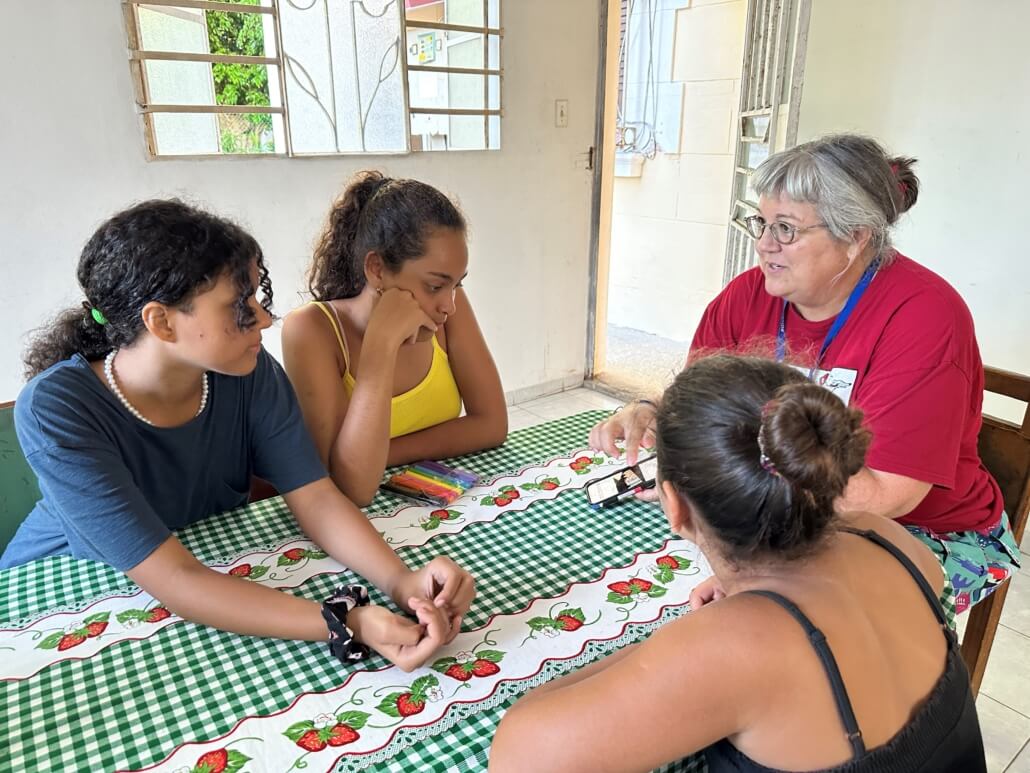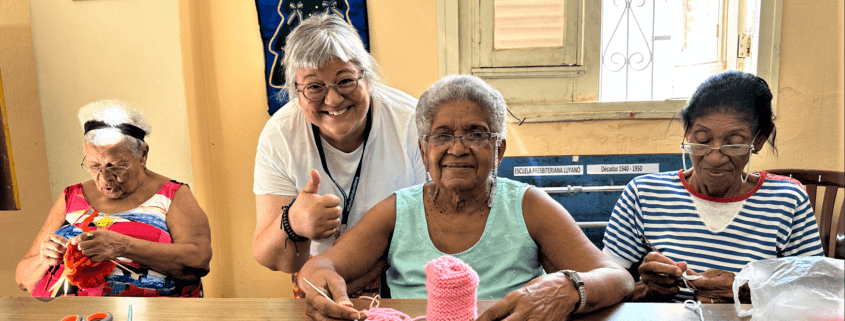“Reluctant Teacher” Says Cuban Teens Inspired Her Confidence
When first-time Global Volunteer and Ameriprise Financial Director, Cindy Hanson, prepared for her Cuba Service Program in 2022, she “overlooked” the expectation she’d be teaching basic English skills for part of every day. Once on-site, she learned that sharing conversational skills with eager teens need not be daunting. “Just discuss what you know,” she was advised. She said it was the best advice she ever received. Read on for her perspective of serving as a “non-teacher” in Cuba.
by Cindy Hanson, Cuba Volunteer
A few weeks before my departure for Global Volunteers’ Service Program in Cuba, I received an unexpected package in the mail: I tore open the envelope and gazed perplexedly at the organizations’ Conversational English Teaching Guide.
While I knew that teaching English is a feature of many volunteer travel programs, including Global Volunteers, in my excitement about about the opportunity to knit and sew with the women’s craft circle in Havana, I let my eyes slide right past the descriptions of English language instruction in the volunteer preparation material. To be honest, I didn’t even think about it.
So, when I received that teaching guide in the mail, my first thoughts were: “I have no experience teaching English as a second language. How would I do this? Could I do this?”
To comply with the Cuban government’s regulations for volunteers, we didn’t conduct formal English language instruction, but rather focused on engaging Cubans in conversation. With beginning students, we played games that helped them build vocabulary. With advanced students who were already fluent in English, we circled our chairs in the church parking lot and had spirited conversations on a wide range of topics. My limited Spanish got me assigned to the advanced students for the first week of my service, which was just fine.

Near the end of the first week, I was promoted. Team Leader Karen asked me to work with the beginners. “Umm,” I guess?” I responded, recalling my day sitting in on a beginners group led by the previous volunteer, who was going home. I wondered how I’d follow in her footsteps. Julie was so organized, prepared, and confident, with her vocabulary flash cards and her comfortable Spanish.
As it turned out, before she left, Julie gave me the key to success with this group in a conversation over dinner. “They’re all big fans of BTS,” she said. “Isn’t that the K-pop [Korean pop music] group you mentioned that you like?”
What? I thought. The group whose albums make up a significant portion of my K-pop music collection? The group that I saw perform live in Los Angeles? The group of whose fan club—BTS ARMY—I am a member (with membership card and number)? The group whose museum installation I visited in Seoul in October? “Yes. Yes, it is!”
And so my first question for the group of beginning students—three teenage girls and a younger boy—was this: “Are you BTS ARMY?”
“Si!” they nodded.
“I am BTS ARMY, too!” I responded.
And then I whipped out my iPhone to share photos I took at the BTS LA concert. Much squealing and cheering ensued.
Eventually, one of them asked me a question in English: “Who is your bias?” (In K-pop speak, your “bias” is your favorite performer of a group that you “stan,” or like.)
“SUGA,” I offered. “Who is your bias?”
“JUNGKOOK!” they responded.
At that point, I knew I was in. And we took it from there.

Over the weekend, I combed through my iPad to find more photos and videos that I shot at the concert in LA. We used these in some of our conversation exercises: Name the performer, name the song, and so forth. They were enthusiastic about all of these except one song, which they couldn’t recognize: “Too much screaming,” they explained.
“Do you know why?” I ask. They shake their heads.
“Jungkook is not wearing anything under his jacket. Every time he jumps or lifts his arms, you can see his abs and the audience screams.”
Zamantha, the oldest student, jumps out of her chair and settles on the floor, less than a foot from my iPad.
“Again,” she says. “Again. Es muy importante!”
We watched that clip about a dozen times.
For better or worse, lack of wi-fi limited my ability to access additional BTS content online during my service. Nevertheless, the students started coming earlier and earlier to class, bringing their friends who were also BTS ARMY. We talked about other topics and engaged in other activities, but we always made time for conversation about our favorite subject. I think this is exactly what the Cuban government restrictions on our work had in mind…. engaging conversations on topics that support and encourage the Cuban people. Sharing our interests and our common humanity.
For our final conversation, I created an exercise using their favorite BTS song, “Butter.” Butter’s lyrics are in English, so I wrote them—with key words missing–on pieces of butcher paper that I taped to the wall of the meeting room. “If you can fill in enough of the blanks,” I explained, “we’ll listen to the song.” We went through the lyrics line by line, talking about their meaning (I had translated them into Spanish with Google as a teaching tool) and adding the missing words. At the end, Team Leader Karen came in with her Cuba phone and played the song for us while we followed the lyrics posted on the wall.
At the end of the evening, I thanked the students for their time and patience with me and told them that since it was our last class together, I wanted to teach them some words and phrases that would come in handy if/when BTS comes to Cuba. We learned how to say Hello, Awesome, I love you, and Goodbye, in Korean.
Before they left, each of them hugged me. Marta, the serious one with the best English who always came to class in her school uniform, left me with a final surprise:
Kamsahamnida (thank you, in Korean), she said.
Kamsahamnida, I responded.
Cindy Hanson lives in Saint Paul, MN. Her visit to Cuba in November 2022 was her first service program with Global Volunteers.




Leave a Reply
Want to join the discussion?Feel free to contribute!